Random Photos on the Farm
/Random photos of the farm during the last week—lambs, weaving projects, classes, and even a horse.
Read MoreJuly, 2023: I have switched to writing most of my blog posts on my original WordPress blog so access all the current news there and sign up on that site for email updates.
Random photos of the farm during the last week—lambs, weaving projects, classes, and even a horse.
Read MoreLambing is well underway with challenges of lots of rain.
Read MoreSheep coats need changing periodically. These photos show before and after changing coats and how the fleece looks underneath the coat.
Read MoreI needed to find some photos for a special request. You’d think that with over 4300 sheep photos (according to Lightroom) I wouldn’t have to take more. But I did. I’ll share some. Most are in the Sheep Portrait category.

Meridian Hazel, one of our very friendly sheep. She will be three when she lambs in the spring.

Meridian Raquel is our second oldest ewe. She will be 10 in the spring. Her upper right horn was damaged and grew down over her face. For years it was right in front of her eye but it broke a few years ago and now she has full vision.

Meridian Janna, almost five years old.

Hillside Hannah’s Grace came from Michigan in 2021. She will lamb for the first time in the spring.
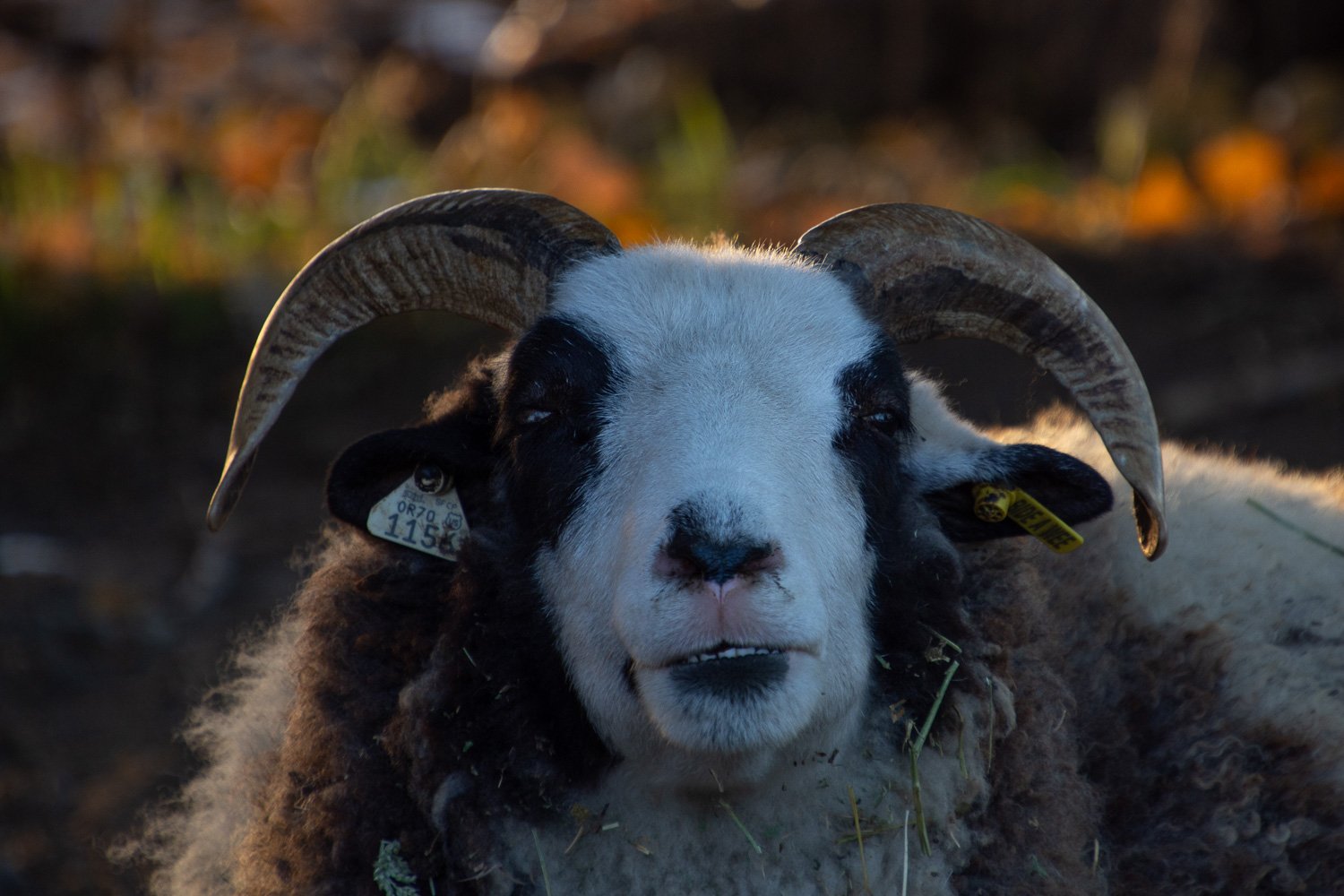
This ewe, bide a wee Hallie, came home with me from Black Sheep Gathering in Oregon 7 years ago.

Meridian Terri, a 5-year-old ewe.

Meridian Lenore, one of the 2022 lambs.

This is Lenore with her dam, 5-horn Sweetgrass Tranquility, a ewe who came from Michigan in 2021.

Another mother-daughter pair. The daughter is Meridian April, the last lamb born in 2022, and her 4-horn dam, Meridian Columbine.

The sheep are still spending a lot of time in the pasture, but they come in as a group to relax. After an hour or so they will get up and go back out.
This is the view from the south edge of the property.

That distinct line between green pasture and dried out plants indicates the difference between irrigating and not irrigating in the Sacramento Valley in the summer. For a variety of reasons parts of the pasture haven’t had enough water this summer. We had to start irrigating much earlier in the spring due to lack of rainfall, and that has an impact on how we spread out our water allotment through the season. Our water allotment is less this year than in the past. Our irrigation “system” isn’t as efficient as we’d like and it’s very difficult to get water to all the areas that need it.

This is the north end of that same paddock. This is dallisgrass that gets coarse and overgrown at this time of year and the sheep don’t keep up with it. They don’t want to walk through it. If you were a prey animal would you want to walk through grass that is over your head—how would you know if there is a lion lying in wait? The sheep are walking in a gap between the tall grass and where I set up the net fence.

They prefer to eat the more vegetative part of the grass and not the coarser stalks and seedheads.

This photo was taken from the road and there is a fence between the sheep and the grass in the foreground. They were on that paddock last and now are on the one with the taller grass. Their heads are down in the shorter grass and that tall overgrown dallisgrass is behind them.

The title of this post says Random Farm Photos. Here is the fleece of one of the ram lambs I have kept for this year. This is Meridian Rascal with fleece like his sire, Meridian Rambler.
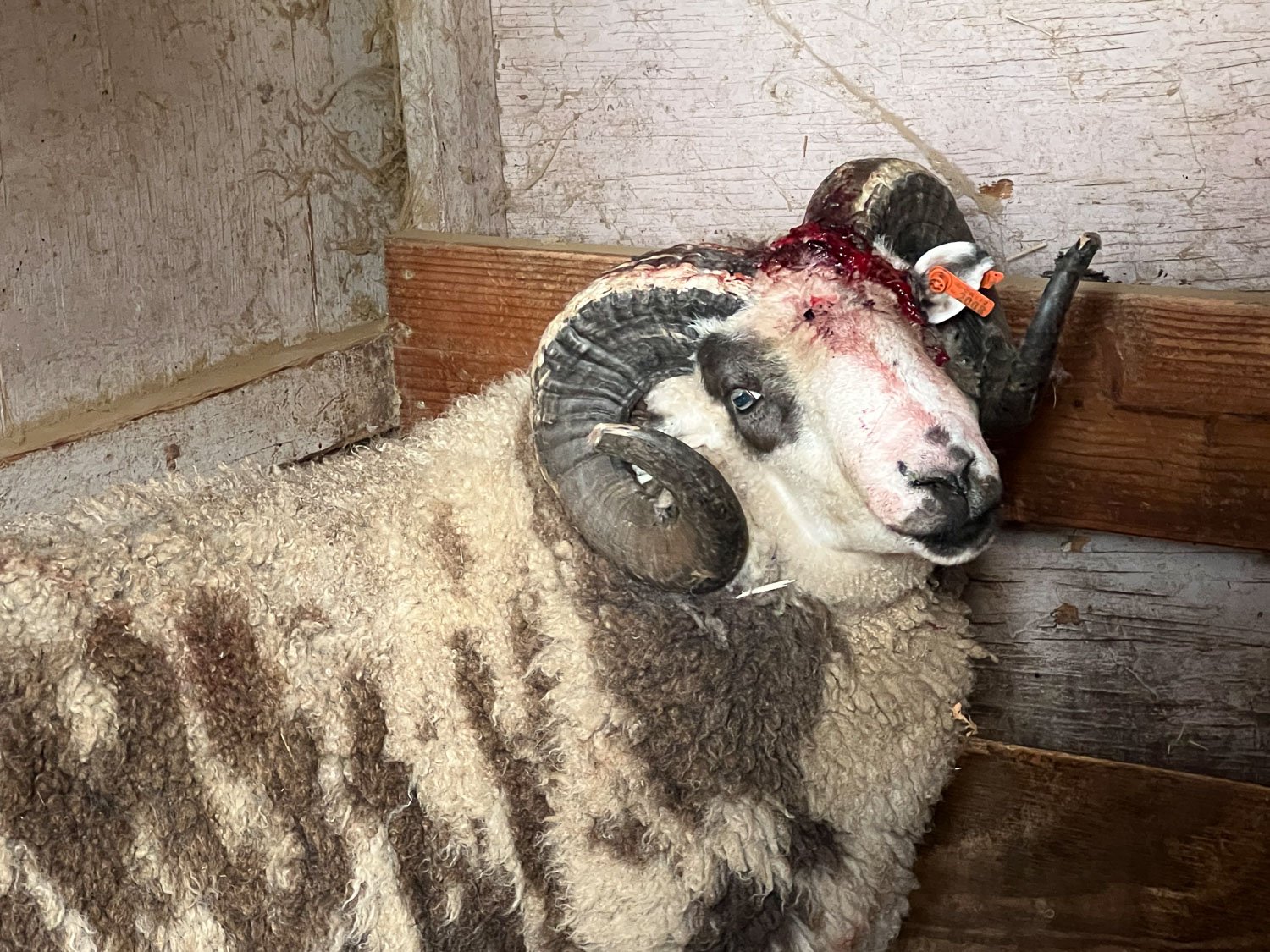
When I fed the adult rams last night one of them didn’t show up. I saw Axis in the barn. He and Barrett were fighting the night before, but I guess they continued the squabble through the day. I hosed most of the blood off his head and sprayed fly repellant on him.

When I was in the barn earlier I heard the chirps of ground squirrels. These two were both up on the top of the fence around the ram pen. By the time I took the photo they were on the ground.

This is the seed pod of a plant called devils claw. The ones above are green and closed. When they dry out they open up and spread into claws with very sharp points. This is nasty stuff to find in a fleece. I dug this plant out and put it the trash. I don’t want it in my compost pile or the burn pile where the sheep have access.

I’m still working on weaving items for the show that I will put up next week. These are three blankets spread out to dry. That’s locally grown wool. The dark wool is Jacob.
This post is just what it says. I’ve taken so many photos with the intent to share them and tell a story, but then I don’t.

Sheep waiting in the shade. They come and go and are in the pasture even when it’s over 110 degrees like it was two weeks ago.

That’s a screenshot from my phone one of those hot days. I forget now how many it was in a row of over 100, but considering that some were over 110 it sure felt like a lot. Thank goodness that is over for now.


Two ram lambs that show a big difference in the spread of their horns. I’d like to hang onto both of these rams for different reasons. They both have good fleeces. The one with the wider horn spread is unrelated to most of the flock. The other is a shade of lilac (that brown/gray color of some Jacob sheep). If I can keep them for several months to a year it will be interesting to see how their horns look at that time.


Before I box and ship pelts for tanning I take photos so I have a record of what I sent and where I sent them. I have shipped 20 sheepskins in the last week or so. It will take from 3 to 5 months to get them back depending on where they were sent.
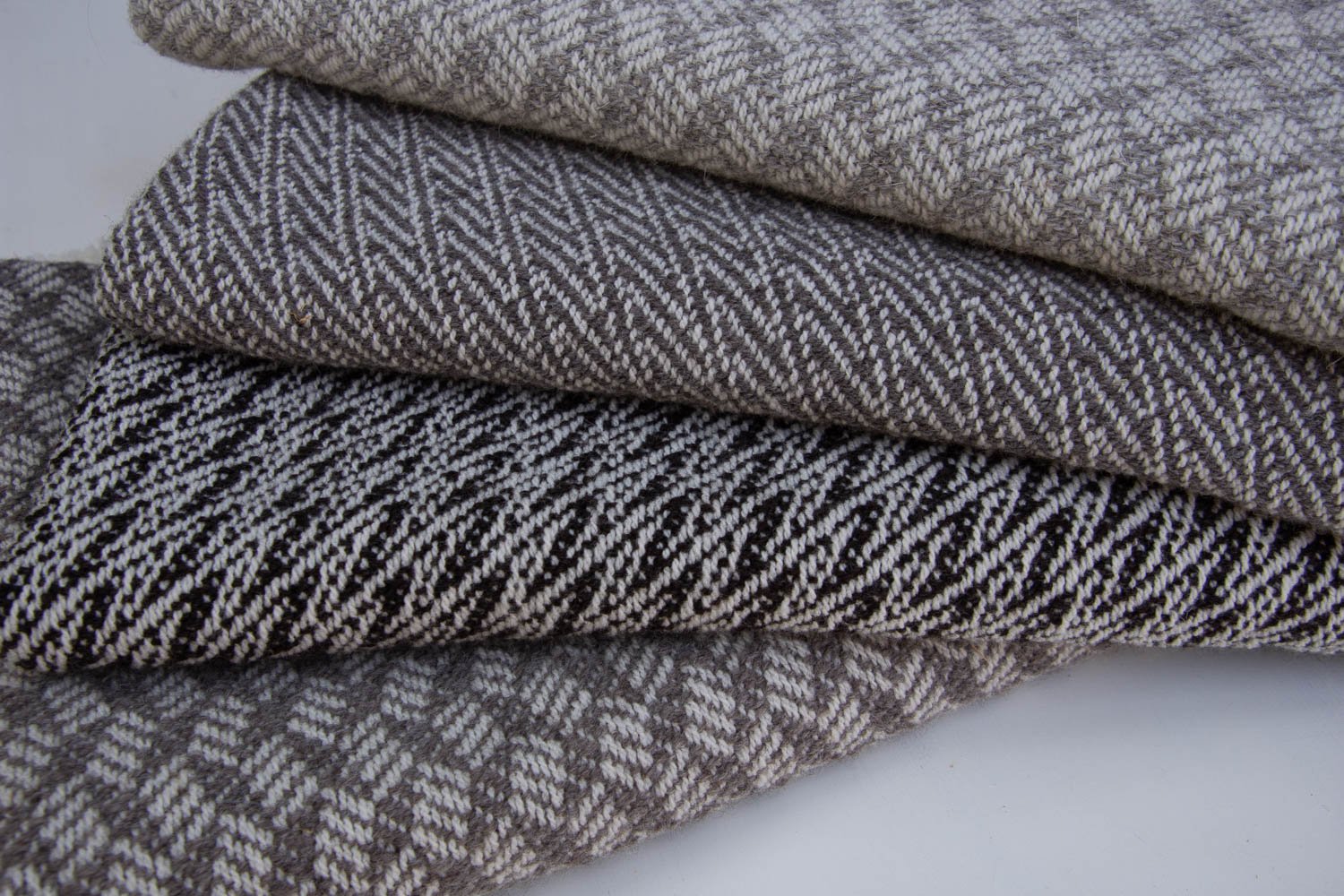
I’m spending a lot of time on preparing for the Shades of Black and White show that will be at the Artery for 3 weeks in October. In fact I will be setting this up the day before I set up my vendor booth at Lambtown. A lot going on. These are some of the latest blankets to come off the loom. These blankets use Timm Ranch wool warp and Jacob weft. They are very soft and I’m thrilled with both of these yarns this year.

This is Jacob wool warp and weft in progress on the loom.

This is how that fabric looks after wet finishing. I turned this one into a mobius shawl. The twist in it allows you to see both sides of the fabric at once. There is no right and wrong side.

This is where I left off tonight on a black and white Jacob blanket.

I was loading the truck today for tomorrow’s event and I heard a suspicious crackling sound across the “bamboo” fenceline that separates us from the neighbor on the north. (It’s not really bamboo, but an undesirable species, Arundo, although it makes a great windbreak for us.). I walked around the fenceline and into the next-door driveway. There was someone standing near the bushes on the right monitoring the fire. Still, with conditions so dry it’s a bit nerve wracking to see.
The neighbor on the west called me this afternoon to say that she saw smoke and called the fire department. They told her it was a permitted fire. I’m surprised that anyone was able to get a permit at this point. Let’s get some rain first.
Back to farm stuff with the blog, although I have a couple of other topics to throw in as well.
Breeding season usually starts October 1. There will be a 2-day delay this year because I’ll be at Lambtown October 1 and 2. I have already scheduled a Farm Day for Farm Club to come out on the 3rd to sort breeding groups and watch the action. My goal is to have all the extra sheep (2022 lambs I’m not keeping and a few cull ewes) gone by then. I don’t have enough room as it is to spread out the groups the way I’d like to.
I want to introduce the rams for this year.
Patchwork Townes is a 2-1/2 year old ram from Patchwork Farm in Georgia. He was purchased by a friend but had some kind of injury shortly after she got him last summer. We wonder if he gave himself a spinal injury by bashing trees. He was down and immobile for a period of time. My friend nursed Townes back to health but was then concerned about his temperament after he’d had all that attention. We don’t like rams to be pets and would rather that they be a bit standoffish. When I go into the ram pen I’d prefer to have the rams walk away rather than approach. My friend offered Townes to me in return for a lamb from him. I jumped at the chance to have the new genetics and a lilac (brown-gray color pattern) ram with great horns at that.

The other three rams with Townes are yearlings, born March, 2021. This is Meridian Silverado (Ruby Peak Tamarisk x Meridian Spice). He is the only 4-horn ram I kept from last year’s lambs. I’m not crazy about his lower horns now. I haven’t trimmed them but may have to at some point.

This shot of Silverado and Townes is a great comparison of the two Jacob color patterns—black and white, and lilac.

Meridian Axis is a 2-horn lilac yearling. (Meridian Axle x Meridian Vixen). Axis is related to most of the lilac ewes I have here and he is for sale. See info on this page.

Hillside Gabby’s Barrett came from Michigan last summer. He sired some of last years lambs, and some carried that distinctive facial pattern.
I have decided to keep more ram lambs than in the past. Its always discouraging when people ask about buying breeding rams and I have sold most of the rams for butcher. With a small property I can’t keep as many as I like, but I chose these to keep an eye on and watch how they grow. I have also submitted registration applications for them so I can sell them as registered rams. These rams were born this year, so they are just a year younger than the three rams above. Introducing the 2022 rams:

Meridian Rascal (Meridian Rambler x Meridian Hilda).

KJ Royalty Thorn. (Meridian Silverado x Meridian Belle). Thorn and his sister belong to my granddaughter who owns their dam, Belle. They live here, but Kirby can show when she is here in the summer.

Meridian Brady (above) and Meridian Bravo (below) are twins. (Hillside Gabby’s Barret x Meridian Roca.) Brady is black and white and Bravo is lilac. It may be hard to tell in the photo but Bravo’s face is a dark gray, not black. His wool looks different, but sometimes it’s hard to tell about the wool without looking at the whole staple length. Look at the fleece photo below.


That’s Bravo’s fleece on the left (lilac) and Brady’s on the right (black).

This is Meridian Turbo, who has the best horns of the two horn rams this year. (Ruby Peak Tamarisk x bide a wee Trista.) Of the ram lambs, Turbo is the least related to most of the sheep in the flock.

I wanted to keep another 4-horn ram and this is him. I haven’t chosen a name yet. (Meridian Silverado x Meridian Sylvia).

I almost forgot the last ram. Peyton is a BFL and I crossbreed a handful of the ewes each year. He sires larger lambs that are ready to sell earlier than the 100% Jacob lambs.
A collection of farm photos taken during the day’s tasks.
Read MoreShearing Day at Meridian Jacobs—we sheared over 80 Jacob sheep.
Read MorePhotos of sheep and the story of why this group is named after nuts.
Read MoreI always like to get photos of all the sheep before shearing. I can go back and compare before and after shearing photos (which I find interesting) and I can find photos of some of the favorites as they have grown up. Yesterday I spent a ridiculous amount of time editing the sheep pages on the website to reflect which sheep are in the flock now. That included making sure I had photos of all the sheep—and I do have updated photos of almost all of them. You can view Our Ewes here and The Rams (and wethers) here.
When I post photos on those pages they are usually of the whole sheep, but I’ll include some close-up head shots here.

Meridian Cashew (Meridian Jasper x Meridian Dilly), born in 2020 and bred to Meridian Silverado. I love this ewe’s horns.

This is Dilly, the dam of Cashew, above. She will be 5 this spring.
I plan to start paying better attention to my ewes’ horn growth. A friend has focused on horns for quite awhile and she has a flock full of ewes with stunning horns. See PatchworkFarm.

Dilly is out of Honey, a ewe who also has nice horns. She will be 7 when she lambs this year.

I was thrilled to be able to bring in a couple of Patchwork ewe lambs last summer. This is Patchwork BettyLou.

This is BettyLou’s friend, Patchwork Amara. She is a beautiful lilac ewe. I did not breed them in the fall because I thought they were too small. It will be exciting to see what lambs they will produce next year. In the meantime I’ll enjoy their lovely fleeces.

At the same time I brought in BettyLou and Amara, Hillside Hannah’s Grace came from Michigan, another ewe with nice horns. I have a T-shirt that reads “You can’t buy happiness, but you can buy a sheep and it’s almost the same thing.” I agree with that sentiment.

A friend of mine is the one who arranged shipping for sheep from three different flocks and I was lucky enough to be able to include sheep in the trailer. If those three lambs made me happy, adding another sheep would make me happier still, right? This is Sweetgrass Tranquility, a three year old ewe due to lamb in March. She is from the Sweetgrass flock in Michigan.
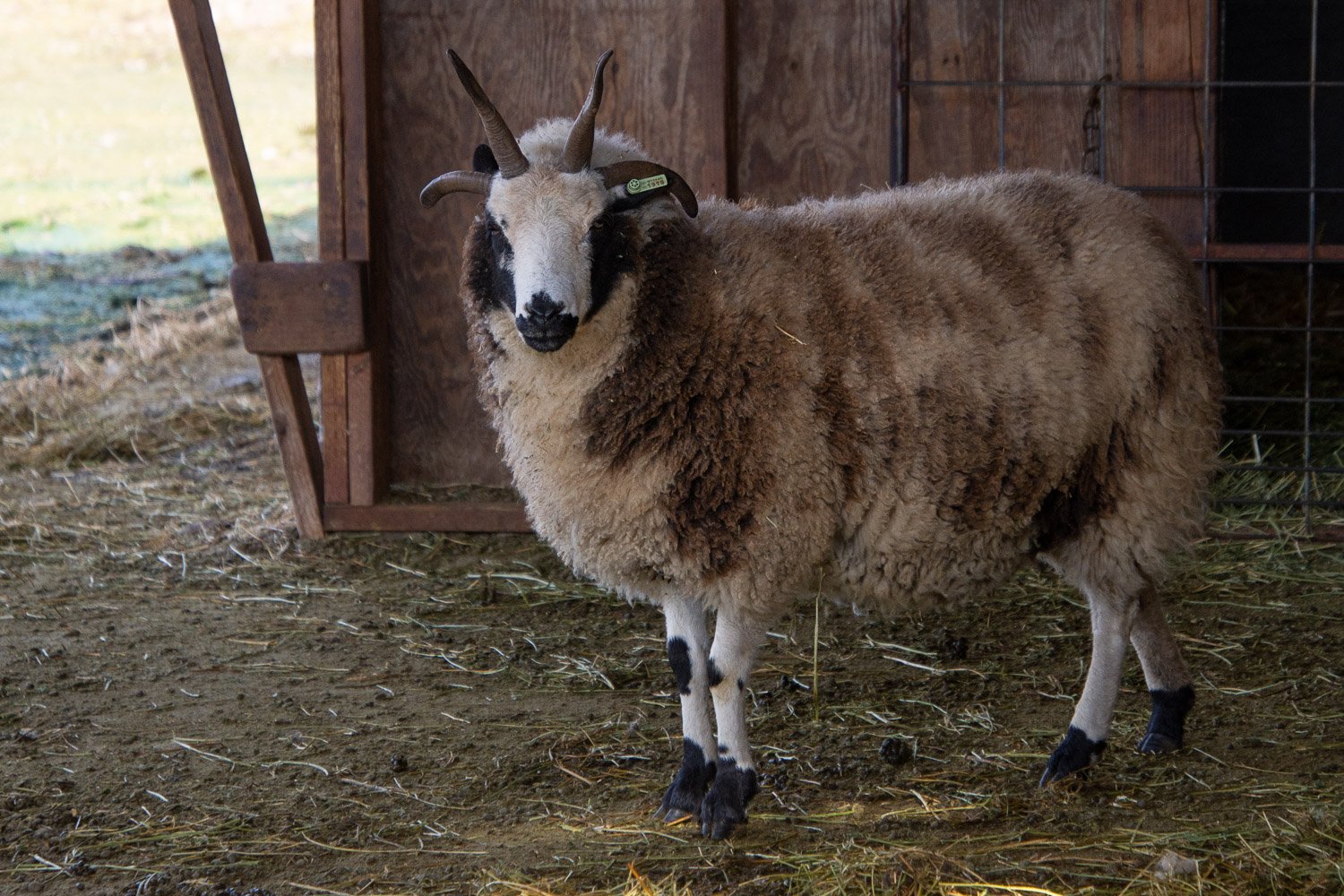
Sweetgrass Eilwen is Tranquility’s buddy.

Since I have gone off the original track to the sheep I bought this summer I thought I should be thorough. This is Hillside Gabby’s Barrett, a ram lamb who bred 7 or 8 ewes in October. I can’t wait for lambing!

Back to the home-grown sheep. This is Meridian Trina (Meridian Axle x Meridian Terri). You can see that her horns, although acceptable, are not as desirable. She is a 4-horn ewe with horns that are fused and therefore somewhat funky looking.

Trina’s dam is Meridian Terri, a ewe who also has fused horns on one side.

Look at Terri’s fleece. Isn’t that beautiful? It’s not all about the horns. There is a lot to try and get right with this breed.

Meridian Sonata is the oldest ewe here. She’ll be 10 when she lambs in March.

Meridian Sylvia is Sonata’s daughter. She has nice upper horns, but the lateral horns aren’t very stout. She was a ewe worth keeping though.

Soprano is another Sonata daughter. I don’t like putting coats on the sheep because I’d rather see the sheep than the coat (and it’s a lot of work to keep up with coats). But this fleece will be stunning because it will be so clean.
Maybe I’ll share more sheep photos tomorrow.
I went out for chores last night and was surprised to find this:

Of course it wasn’t in a pen with nice clean straw. I had no idea that there would be a lamb so I haven’t been watching for them.
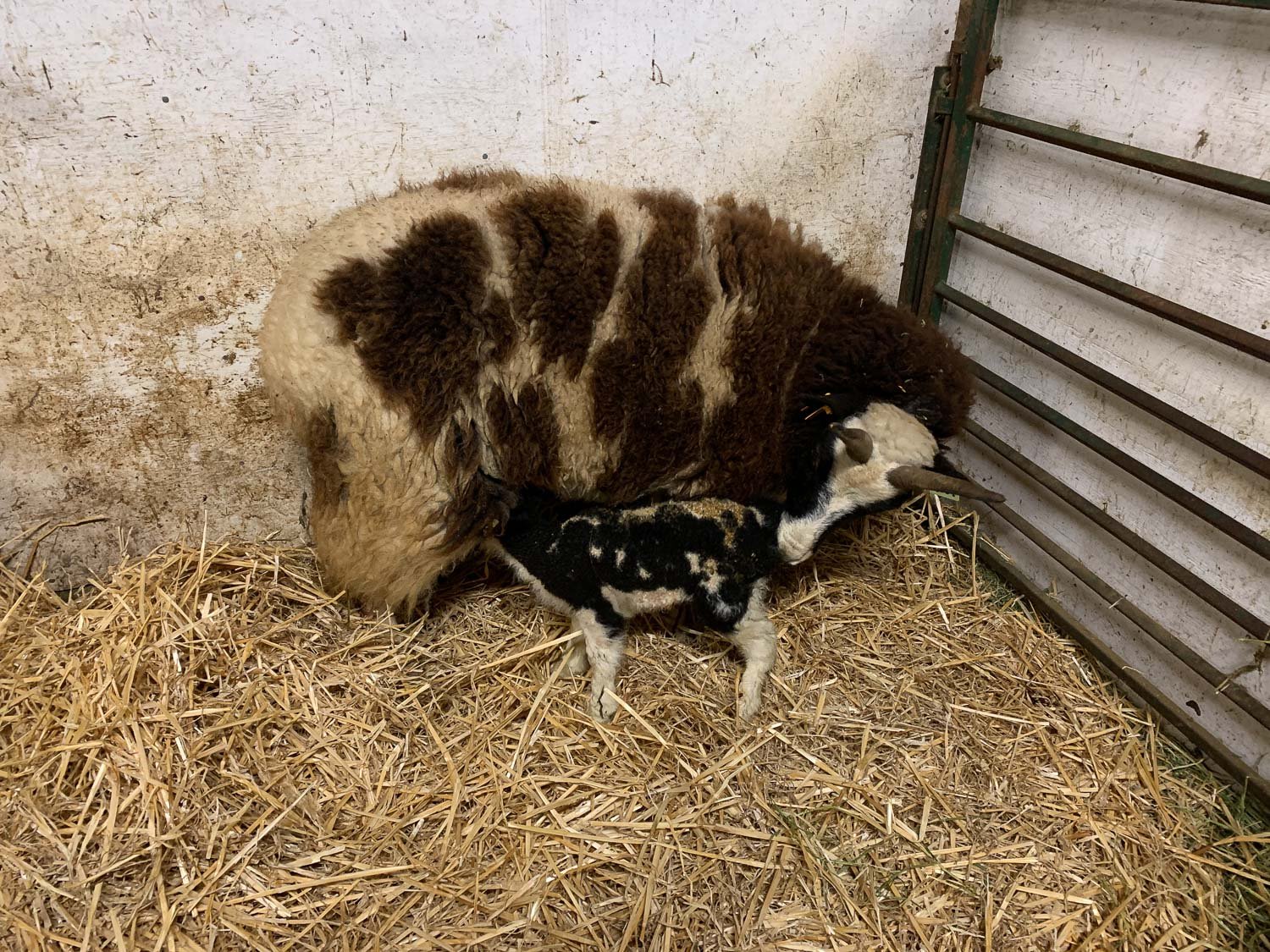
Lambs aren’t due until February 28. I checked back on my calendar 5 months and we were in Texas when this ewe would have been bred.

I checked with people who were here to find out if there were any break-outs (or break-ins) while we were gone and no one can think of anything. That means that I didn’t get all of the ram lambs out of the pasture when I had intended to. I meant to do it by the time they were four months old but I must have missed someone.

This ewe, Spice, is one of two ewes for whom I did not have a breeding date. The other has a fertility problem because she has never been bred and was confirmed open when we did ultrasounds a few weeks ago. The vets did ultrasounds on all the ewes and found 2 open that I thought would have been pregnant, but 52 other ewes that are pregnant.
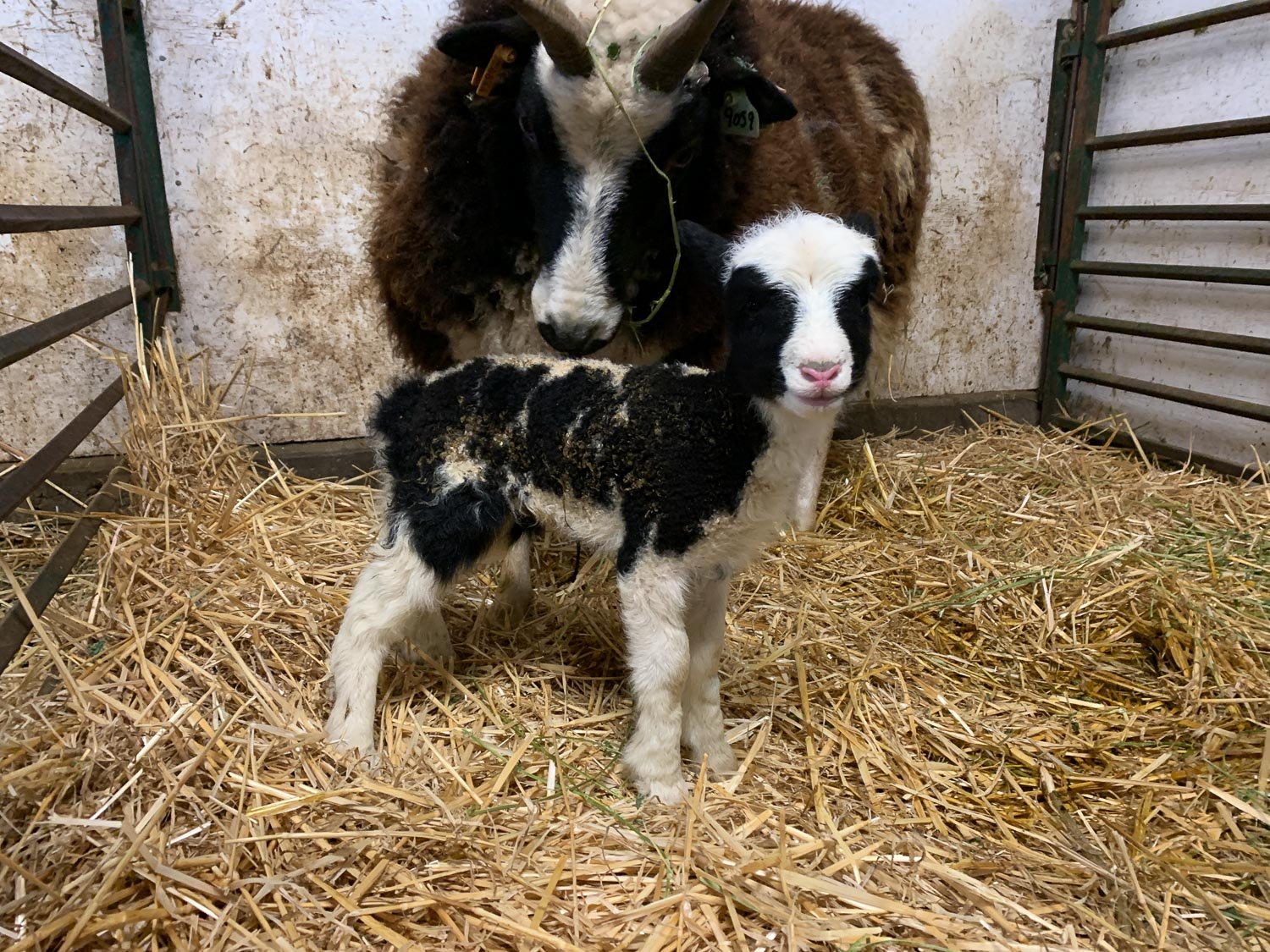
Farm Club members have suggested names: Yule and Surprise so far. I was wondering about OOPS!

After so many years of drought, maybe we’ll start to catch up. There is a lot of snow in the mountains and we got more rain yesterday. In the late October storm and this series of storms we have alsost more rainfall already than we got all last year. This photo is last night’s total. We had 3” a couple of days ago.

That much rain all at once makes for a mucky mess. Dan made a bridge for my wheelbarrow. This is why farmers don’t throw things away. That structure was one that has been around here for quite awhile—I think we may have got it from a friend when he moved years ago. It’s been the elevated path between the two houses since we had that October rain. Now it’s going to work as a bridge out here.

I looked at this view over the gate this morning and thought that the sheep looked very festive with their red and green markings.

One last photo. This was on Saturday as I was driving home from Sacramento. (Traffic was stopped so I as able to get this photo at no risk.)
In yesterday’s post I talked about trying to keep fleeces clean and mentioned the problem of the goats dropping hay on neighboring sheep. This morning I noticed this:

This is just what I mean about how goats eat.

Here is the other goat.

She turned her head to the side and dropped a big chunk of alfalfa on the sheep next to her.
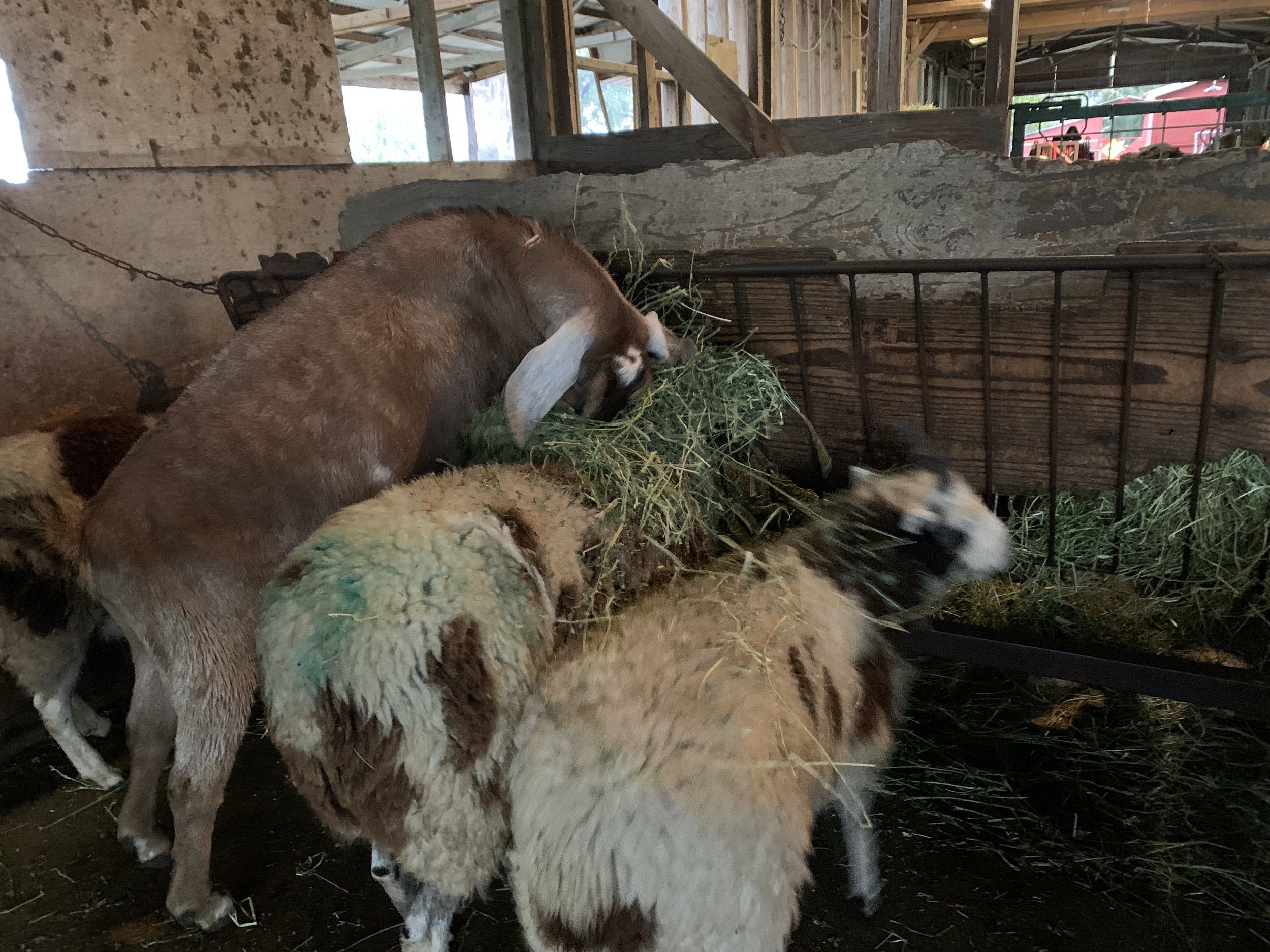
Not a good sight when I plan to shear soon.
I outsmarted the goats. They are now in another pen by themselves. I feel bad about that because they are not happy. But they have each other, there is plenty of room for two goats, and they won’t get into trouble. Maybe I’ll put the back with the sheep after shearing.
People always ask why some sheep have coats or covers. If you’re a spinner you know the answer. Spinners want to work with the cleanest wool possible. We’re not so worried about dust and dirt that accumulates from living outside. It’s the vegetable matter (known as VM) that is the problem. VM includes bits of alfalfa or grass hay in the fleeces of sheep fed in the barn or foxtails and other seedheads from pasture or range plants that have gone to seed. What do you know about seed dispersal? The most successful plants have developed means to get their seeds spread as far as possible. That often refers to foxtails or burrs or stickers that get caught in sheep fleece or your socks or your dogs’ fur. Washing does not remove VM. Some of it drops out with carding or combing, but much does not. In large (huge) commercial mills there are chemical processes to remove VM, but those are not available (or desirable) in our small and mid-size mills.
So how do we avoid contaminating fleeces?

KEEP HAY FROM DROPPING ON SHEEP. When I feed I chase them all out of the barn and close the gate. Then I put hay in the feeders before letting the sheep back in. At least that way I’m not dropping hay on sheep. Notice the wood panels in the feeders. The sheep feed from the base of the panels…EXCEPT for those sheep who insist on putting feet on the feeder and grabbing mouthfuls over the top. The goats do that all the time—grab a mouthful and then turn their heads and drop it on the nearest sheep. This is not a perfect system.

Coating sheep is another way to promote VM-free fleece. Some farmers who are well known for growing premium wool coat all their sheep. I choose a few to coat. It is usually those sheep that have been shown at a fair or fiber show. I use coats during transportation and at the show and then continue to coat them for the rest of the year. There have been no shows now for two years so I chose a few to coat anyway.
There are issues with coats. One is that I don’t like looking at coated sheep. I like the spots and the natural look of my sheep and that is how I’d rather see them. The other issue though is the amount of work involved. Not only do you need to change coats at least 3 or 4 times a year as the fleeces grow out, but there is a lot of coat maintenance, something that is worse when you have horned sheep. The coat on the sheep above is doing much good at this point.

Another problem coat. In this photo you can tell one of the benefits of coating sheep. The fleece maintains a darker color throughout because the tips aren’t sunbleached. This is a lilac sheep so her fleece is a brown color instead of black. You can tell the difference the coat makes by comparing the uncoated neck wool with what was under the coat that is now torn and dragging.

This is Quora, a ewe who will be two at her next shearing. The coat is not only torn but is getting too tight as the wool grows. This photo was from August of this year.

Here is how the fleece looks.

These are the coats I replaced earlier in the year. These have all been washed but now need to be repaired. I do not have an industrial sewing machine and a home machine can only do so much. I can sew rips and use patches, but it gets tricky when you have seams in multiple layers of thick fabric.

I changed four coats this morning. This is Quora, the ewe whose torn coat was replaced in August. This one is getting tight around the neck and is also torn.
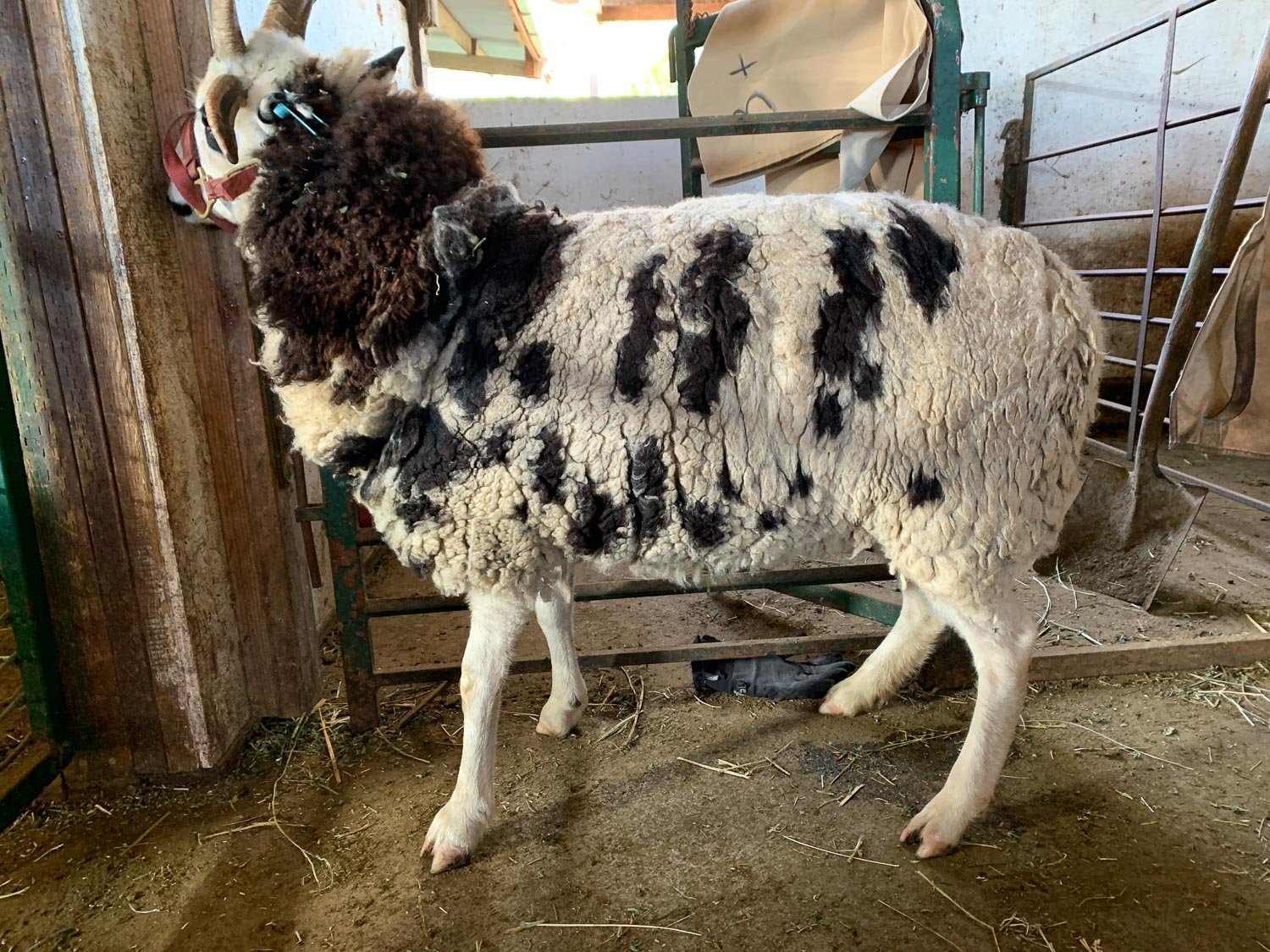
Notice the true black color where the coat was protecting the wool.

I may need to claim this fleece for myself.

Here’s the new coat—Size 4+ .

I don’t have a photo of this ewe, Pecan, before removing the coat but you can see from the neck and tail now tight that coat was on her. Pecan is another lilac ewe (that gray brown color instead of black).

Pecan’s fleece. Wait! Maybe I need to keep this one.

Pecan in her new coat—still sort of tight on that fleece. We have 7 weeks until shearing. Can this coat last?

This is Pecan’s twin, Sandie, with her coat removed. Her fleece is still in good shape, but when coats get too tight they can contribute to felting on the sheep.

Sandie’s fleece.

Sandie’s new coat.

Soprano’s coat wasn’t as tight as some of the others, but it definitely needs repair.

Soprano’s fleece.
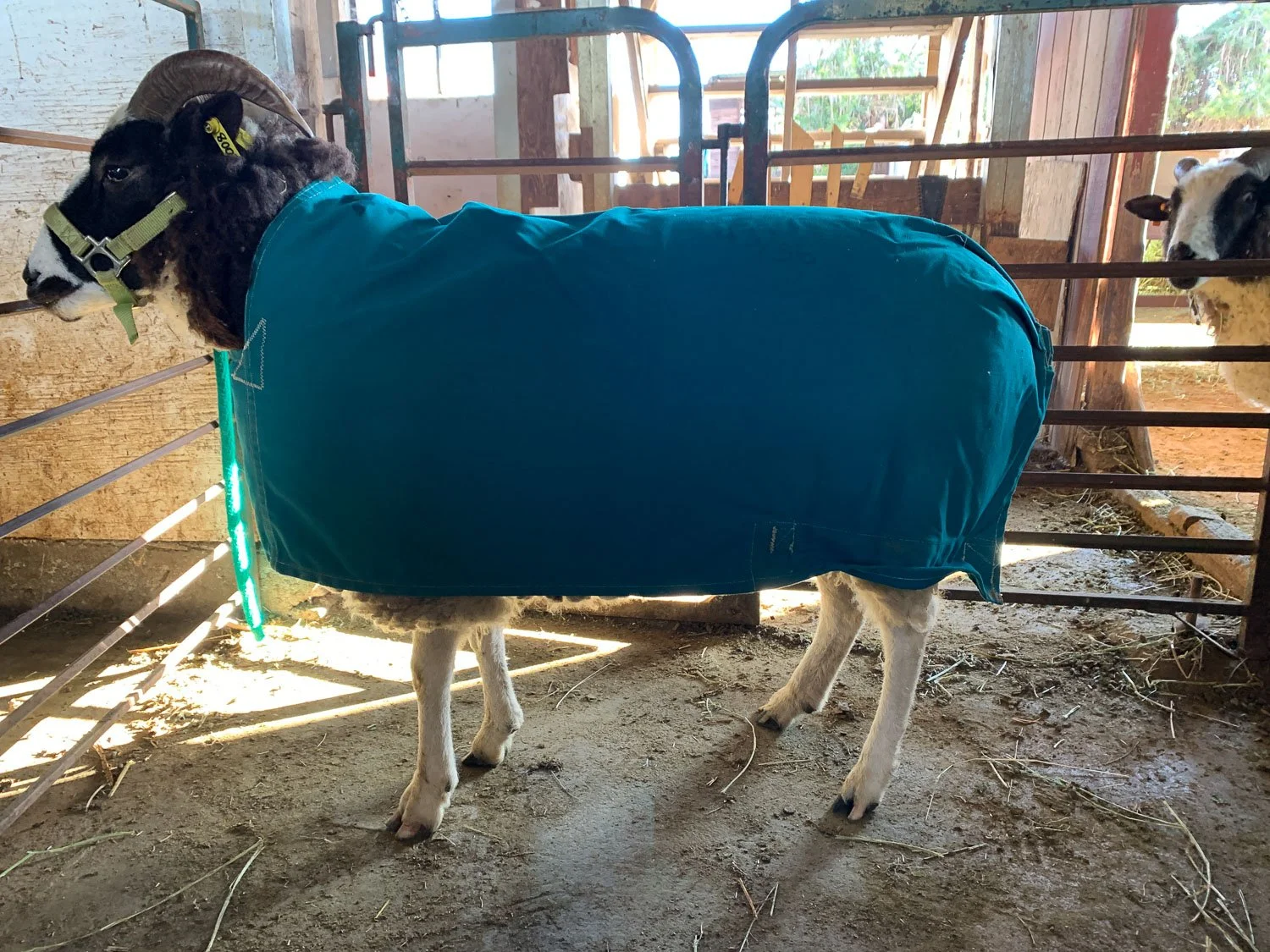
This coat is a better fit and has no repairs… yet.

These are the four ewes whose coats were changed today. I think there are two or three other coated sheep in the flock.
It’s pretty quiet around here now. We just spent the last ten days with grandkids here or nearby. We share the two grandkids with the other set of grandparents who live in Dixon. Katie and the kids got here about ten days ago and Kurtis came about five days later. They split their time here and in town. For the first couple of days my son, Chris was here as well, but he had to get back to Boise, where he and Meryl moved just a few weeks ago.

Right after they got here the kids wanted to get out the toys they remembered from previous visits. There are a selected group of toys left over from when my kids were younger. Kasen had the box of Lincoln logs and the wooden train set. Kirby went right to the Playmobile cowboy set that she remembered from her visit in the summer.

Kirby always likes to spend time in the barn when I do chores. Katie came out the first morning and offered to help with cleaning. You’d think from this photo that they are worn out, but I think they were faking it.
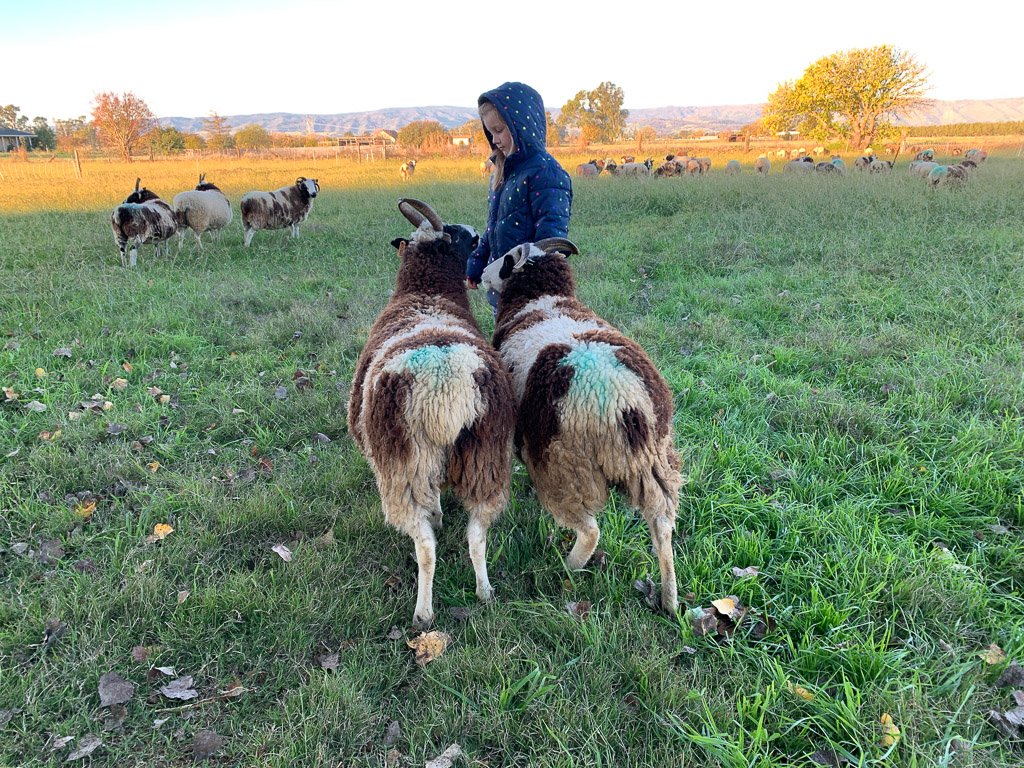
Jade and Hazel are really going to miss Kirby. She spent a lot of time in the barn and in the pasture and those two sheep always hang around her to get pets (and sometimes treats).

One of the mornings we drove to the Yolo Bypass Wildlife Area between Davis and Sacramento.

The majority of birds were to the east past the line on our map that showed the division between hunting and no-hunting. So we watched and listened to those from afar. I think it’s fascinating to see the city buildings just beyond these massive flocks of birds.

This isn’t a great photo but I think these are sandhill cranes. The majority of the birds in the large flocks to the east seemed to be snow geese.

On Wednesday we spent the afternoon and evening with my brother’s family in Fairfield. Before our Thanksgiving meal the kids played football in the street…

…and then went on a Beaver Walk. Dave usually finds beavers at dusk in this creek, but we missed them on this evening.

After our turkey dinner and traditional pies we also had a mini recognition of Kasen’s birthday which is during “the holidays” and when he’ll be back in Texas.

On Thanksgiving Day we celebrated my mother-in-law’s 90th birthday. My sister-in-law organized the party and about 50 family members of several generations came from all over the country.

Kirby in one of her several holiday outfits.

Kirby joined in with the Wild Woolly Wreath class that I did on Saturday morning. This was also presented virtually while I had 5 in-person class participants. The whole Thanksgiving weekend was a bit of a challenge for me with virtual presentations each day through Camp Yarnsie. These were fun, but I had to focus on my organization for the weekend. Camp Yarnsie? That’s a virtual fiber festival. If you missed all it you can catch replays of a lot of the programs here. I had something on each day of the Camp. Check out the video on Thanksgiving Thursday and the Jacob sheep discussion on Sunday.

On Monday my Wednesday Weavers (virtual on Wednesdays) came for a dye day and Kirby joined in. She dyed some of the warps that I have planned for v-shawls and then I made a warp for a smaller version so that she could dye one that I would weave for her.

Kirby usually leans towards the pinks and purples, but then I wanted to use up some of the dyes left over and she dyed this one yellow and green.

She liked the yellow and green one so much that I wound another warp for her and set this up in the house so she could dye this last one before leaving for the airport this morning.

After the dye project we went to the barn for one last session with the sheep before the kids had to leave.
We ended the second day in Idaho by loading up Chris’ motorcycle and some other belongings that we would transport back to California. Then we hit the road and ended up in a motel sometime after dark. The next day we drove to Ketchum to catch the parade that is on the last day of the Trailing of the Sheep Festival.

We were rewarded for not driving this part of the route in the dark by seeing the fall colors along the way.

This is the town of Hailey and some of the Trailing of the Sheep Festival activities were here. Sheep played an important role in the economy and history of this part of Idaho. The amount of money represented by the sheep market from the mid 1800s to mid 1900s and beyond is in the billions in today’s dollars.

Now it’s not all about sheep, especially in this valley where winter sports and recreation have a large role. As you know if you follow my blog I keep myself amused by taking photos of things of interest along the way…things like a giant bicycle…

…and a colorful sheep.

Ketchum is just up the valley from Hailey. We parked outside of town and walked to the parade route. Like any other small town parade, people had staked out their spots with lawn chairs. We found a spot with a view and waited for about 45 minutes for the parade to begin. The sheep spend the summer grazing in the high mountains and are trailed down the valley to lower elevation for the winter. This festival was developed as a way to recognize this history and the people involved and promote the concept to the modern residents.

A mounted color guard. The horses were decorated with sparkly rumps, but I already have enough photos to share so I didn’t include that one.

The dignitaries of the town and the parade were transported in the first horse drawn wagon. This is the Lava Lake Lamb Camp wagon from Hailey.
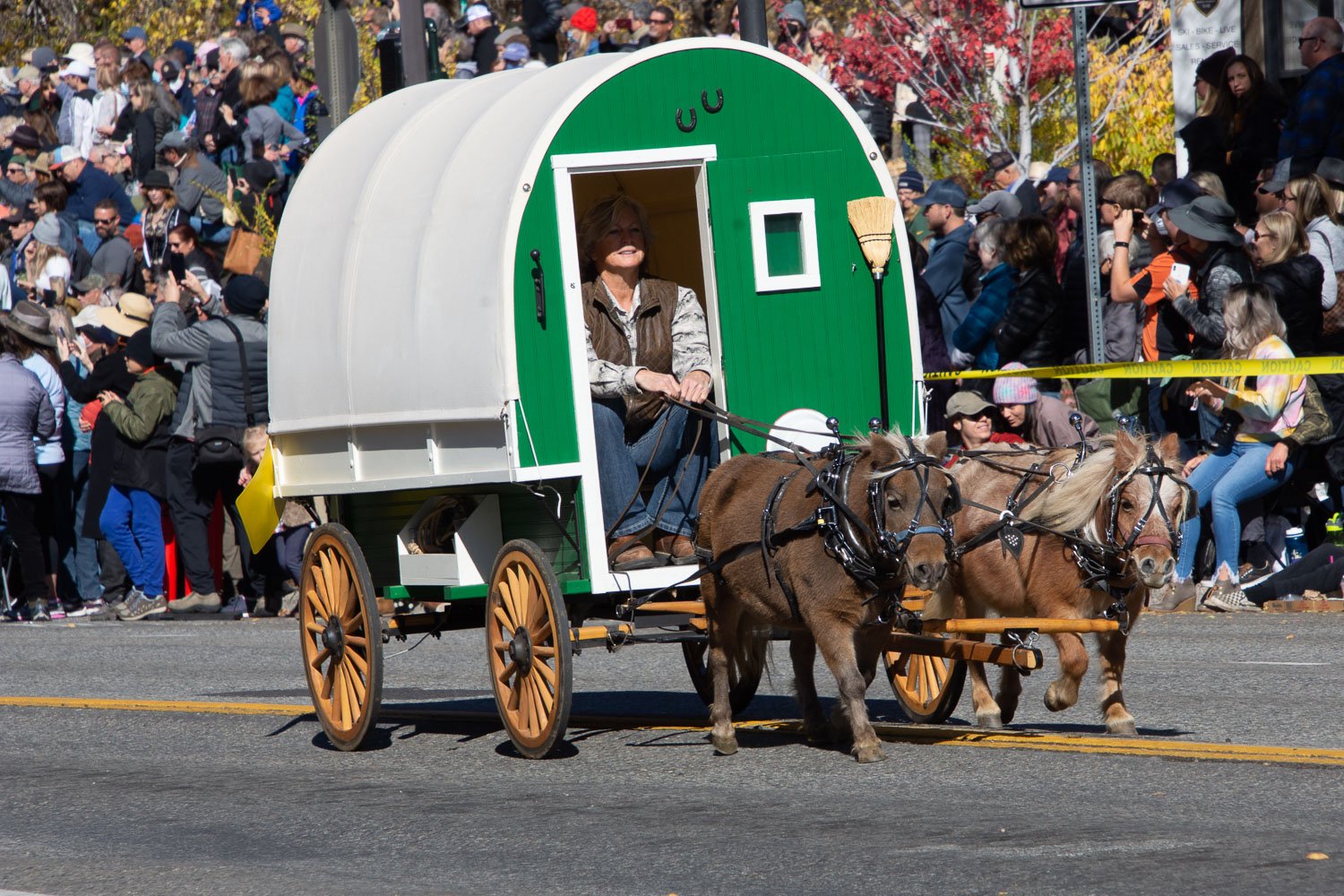
Hook Lamb camp wagon pulled by miniature horses.

This is the Jones Sheep Camp. They call these wagons camps because they are the basis of the headquarters or camp for the shepherds who stay with the flocks in the mountains all summer.

The Ben Holland Sheep Camp, with a double wagon.

The parade included Basque and Peruvian dancers and musicians and the festival recognized the importance of those cultures to the sheep industry . Many of the original Basque herders settled in the valley and became sheep owners themselves. Today the industry relies on Peruvian herders.

This is Miss Lamb Chops and I don’t know the story about her.

It seems that where you find a wool celebration you often find a Scottish component. Scots settled in the valley and played an important role in the early days.
I saved way too many photos for this blog post so I’m going to make this Part 1 and finish it off with Part 2. While you’re waiting for that, take a look at these bagpipers. Do you notice anything odd?
To be continued…
I was was frustrated over some tech issues I was having yesterday and decided that my sheep and my camera would help me get over it. So…

I’ll start with the rams. This is Orion, a ram lamb that is for sale. I love that wide horn spread.

Dylan, a nice ram lamb, but not on the breeding line-up.

Axis is a lilac ram lamb who will have a group of ewes.
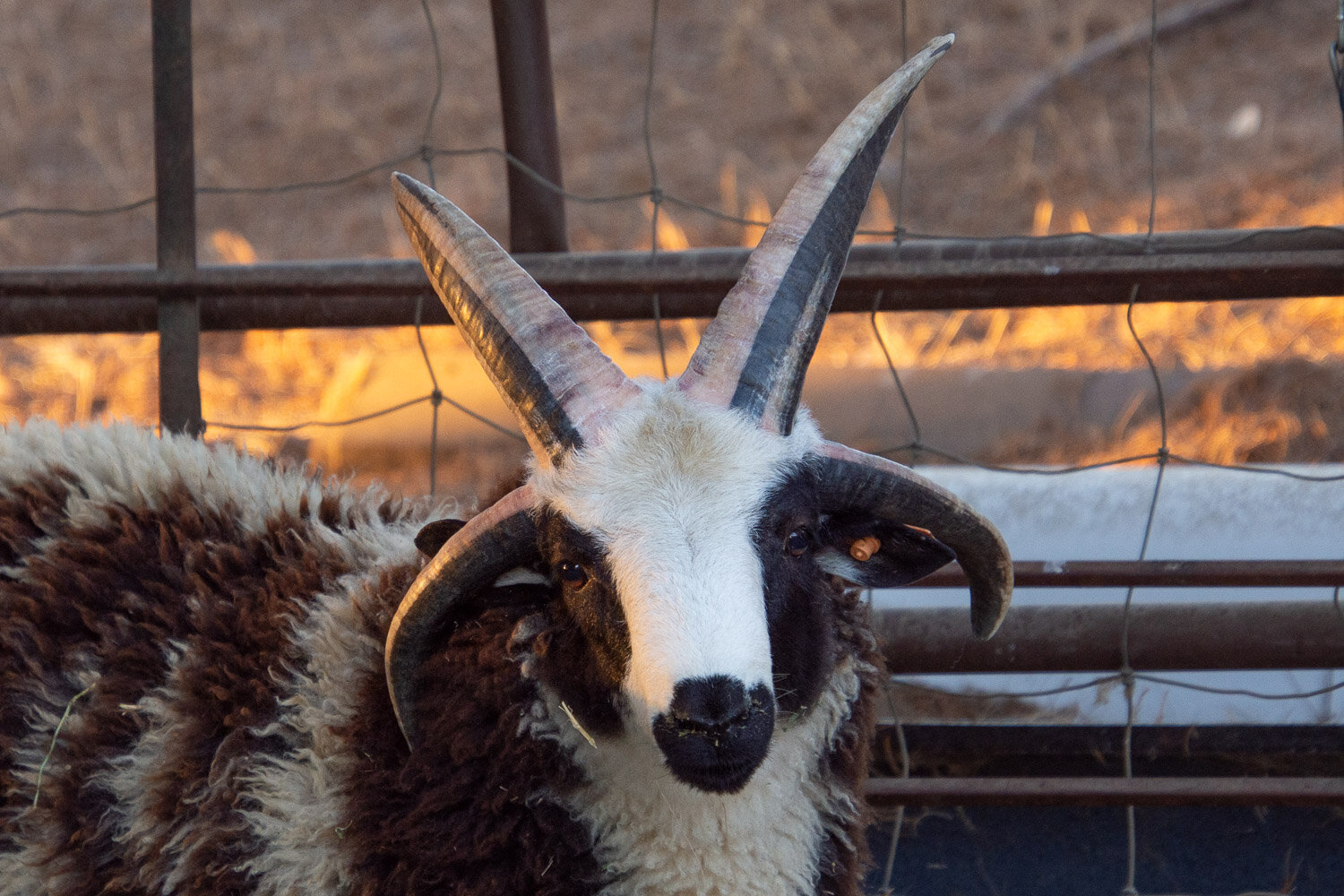
Silverado will have a group of ewes.

Hillside Barrett is the only one who wasn’t born here. He came from Michigan last month. He is younger than the others but will have a few ewes.

Billy is a wether who is kept around as a buddy for a sheep that needs to be separated from the others for some reason. He was with Barrett when he first came and now is with Dylan. Dylan just came back from a friend’s farm and I don’t want to deal with the fighting that there would be if I put him in directly with those other rams.

Speaking of wethers, here is Rocky. A wether’s horns stop growing at the rate they would have grown if he was still a ram. These horns would have prevented registration for this guy. I needed a wether a few years ago and he was handy. Now he is still here living the good life with nothing to do except eat and grow wool.

This wether does have a job. He is the full-time best friend of the BFL ram, Peyton, who I don’t want to put with the Jacob rams.
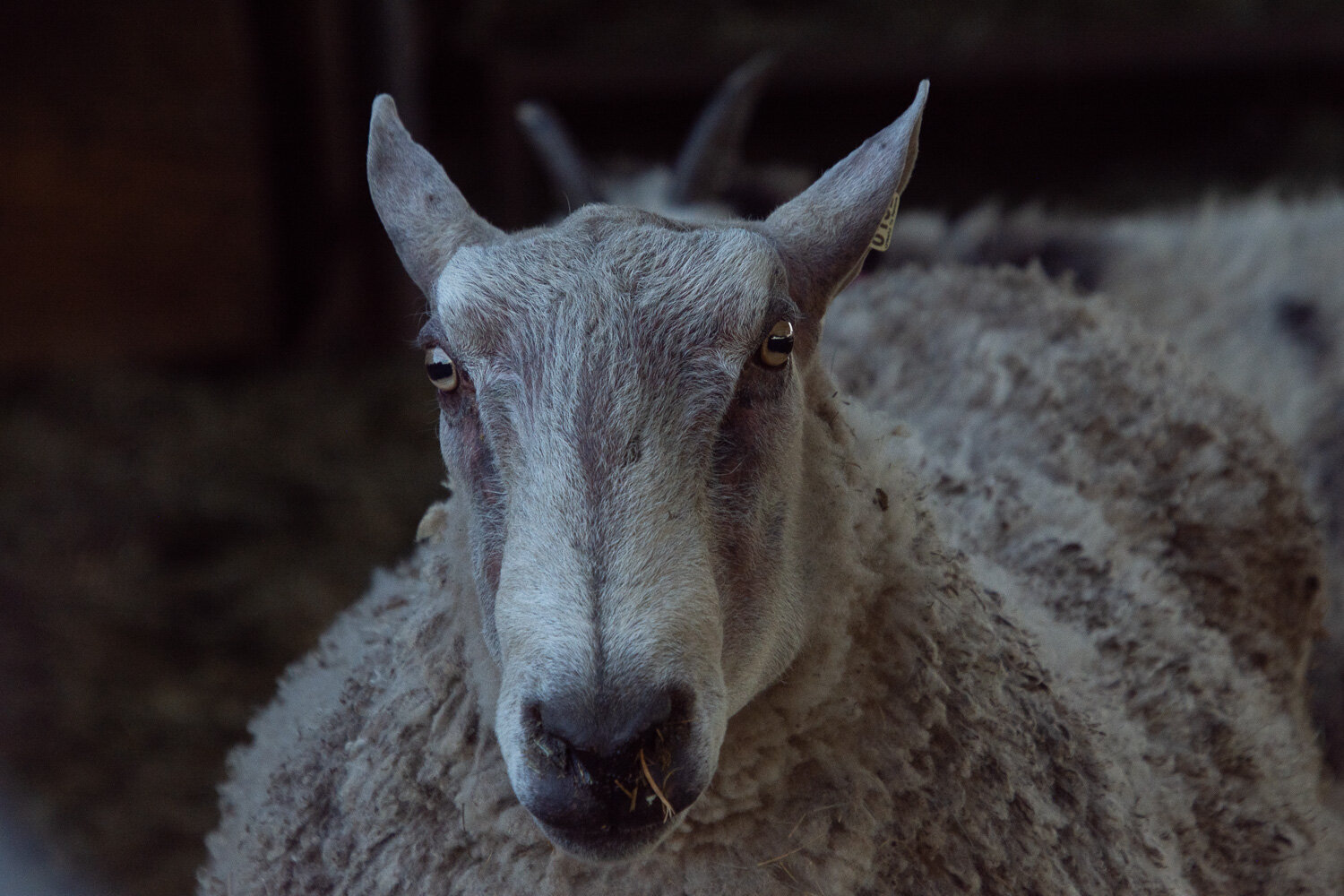
Speaking of Peyton, here is is. I liked this view best of the ones I took last night, except for the unfortunate location of the wether behind him—like the kid putting up “rabbit ears” behind someone in a family photo.

Rambler, the yearling ram. He’ll have a large group of ewes. So will Tamarisk, but I’m missing his photo.

Not a sheep, but a face. Ginny was posing on my way from the rams to the ewes.s

This is a yearling ewe, Pecan.

This is Pecan’s sister, Sandie. They happen to be two of the ewes whose fleeces I chose to protect with coats. Those fleeces will be sought after on Shearing Day in February.

A lilac ewe, Zora.

This is Patchwork BettyLou, one of the sweet lambs that came her last month.

Amelia, a Nubian doe. I love how expressive she is with those ears.

Sweetgrass Eilwen who came last month when I got those lambs.

This is Eilwen’s friend, Patchwork Tranquility.

Last but not least these are the three lambs that came last month. They are always together. Hillside Grace, Patchwork Amara, and Patchwork Bettylou.
A friend who raises Jacob sheep in Pennsylvania emailed me that a ewe that came from here won Champion Jacob ewe at the Garden State Sheep & Fiber Festival in New Jersey. Since all the shows I might have gone to out here were cancelled I’ll live vicariously through others’ fun events, and this news prompted me to write this blog post.

This is Royal Unzicker of Ivy Brook Meadows with Meridian Saffron. At the shows I attend in California and Oregon sheep are shown as lambs and yearlings, but Royal was able to enter Saffron in an Aged Ewe class at this show. (Thanks to Brittany Smith for this photo and the one of the ram.)
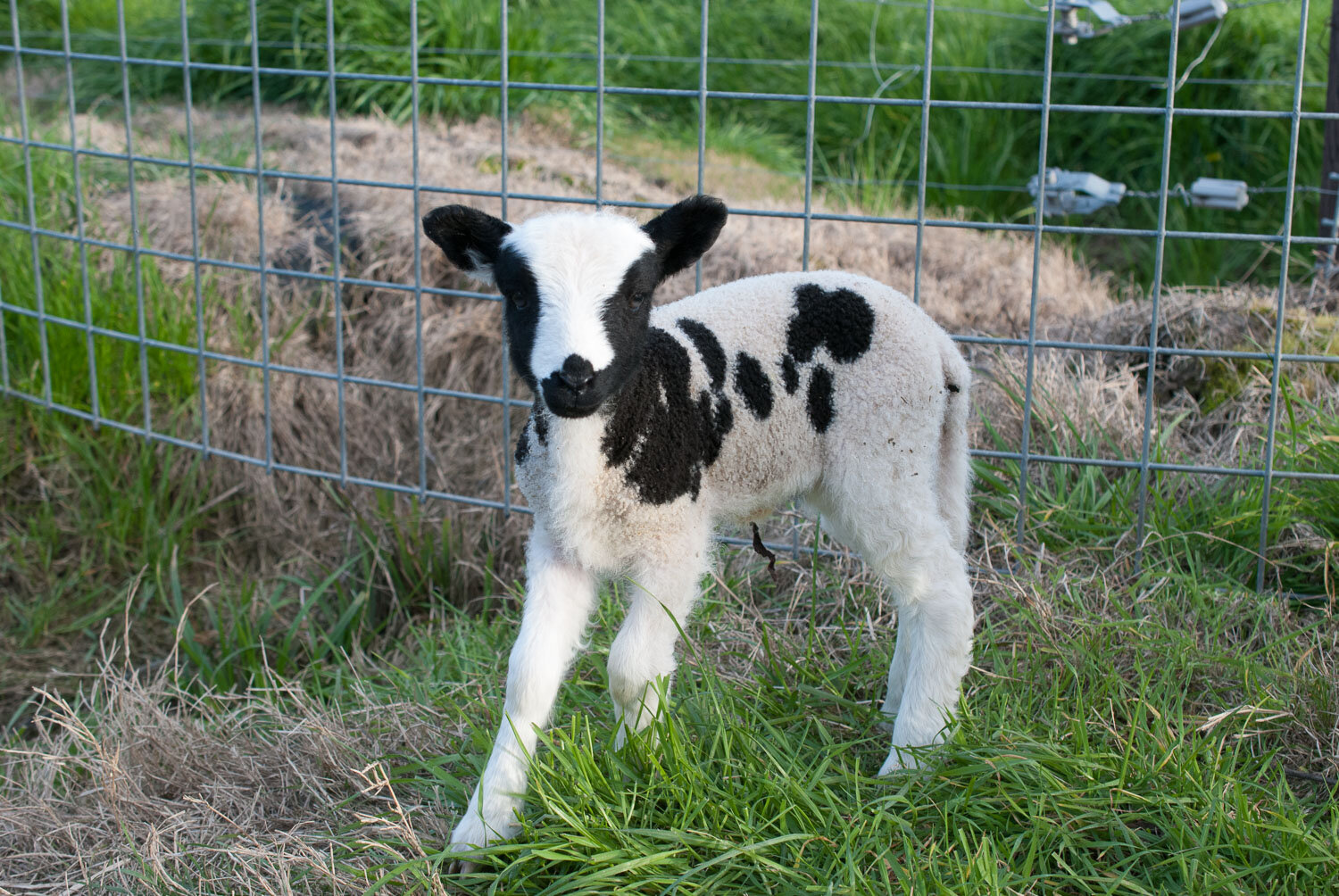
Here is a baby picture of Saffron in 2017.
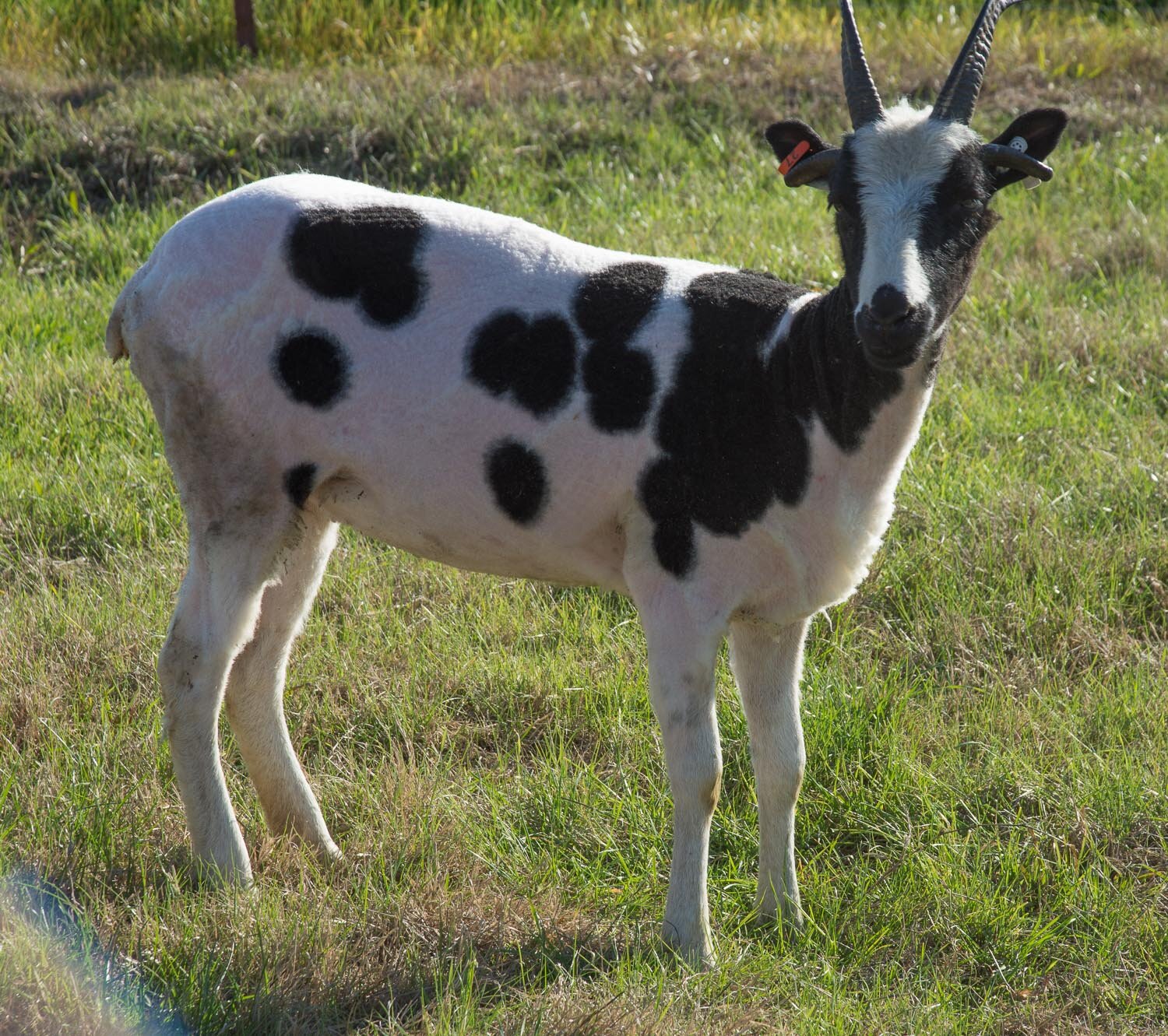
Here she is after her first shearing.

This is what her fleece looked like before shearing. Royal bought Saffron in 2018 with the plan that she and two other yearlings could make it to Maryland Sheep & Wool Festival in May by catching a ride with the sheep of another friend who shows back there every year.

Saffron’s sire is bide a wee Buster of the Bide a Wee farm in Oregon. This is a photo from his first season of breeding here.

Buster is on the left with Clark, one of his sons, on the right. I find it interesting to compare the lamb and adult photos. Buster has sired a lot of sheep, some of whom are still here.

The combination of Sonata (the ewe in this photo) and Buster produced another nice lamb, Soprano, in 2018.

This is Soprano as a yearling at Black Sheep Gathering in 2019.

Royal did very well at the show where he showed the Champion Jacob ewe. He also showed the Champion Jacob ram, the Reserve Champions, and Best Flock. This is Patchwork Cooper. Patchwork Farm is where two of my new lambs came from and I think Cooper is somehow related but now I don’t remember how. I sure love those horns.
I think that I should add here, that it’s not all about the showing. All of us have plenty of nice sheep that have never won awards and we all point out that it is just one person’s opinion on one day so it’s not really that important. But, hey, the shows are fun and why not brag when you have the chance? I hope that we’ll be able to do a little bragging next year, but the first step will be that the shows won’t be cancelled. The biggest news I heard about the California State Fair for 2022 is that they have a new category to enter—Cannabis. Is that enough to make sure the fair goes ahead as planned?
I introduced the girls yesterday. These are the boys who are staying.

Meridian Silverado (Ruby Peak Tamarisk x Meridian Spice) has promising horns and nice fleece. I hope the horns continue to grow as wide as they look in this photo.

This view shows that the horns could be aiming for the neck, but in person it looks as though there is a slight curve at the tips so I hope they grow pointing away.

Meridian Dylan (Ruby Peak Tamarisk x Meridian Lavendar) is very similar to Silverado and I will keep watching his horns as well.

Meridian Atlas (Meridian Axle x Meridian Vixen) is a lilac ram, twin to Lupine who was in yesterday’s post.

Meridian Orion (Ruby Peak Tamarisk x Meridian Skye) is the last ram I have here for sale as a breeding ram. He has a great horn spread and nice looking fleece. He is listed on the ram lamb page.
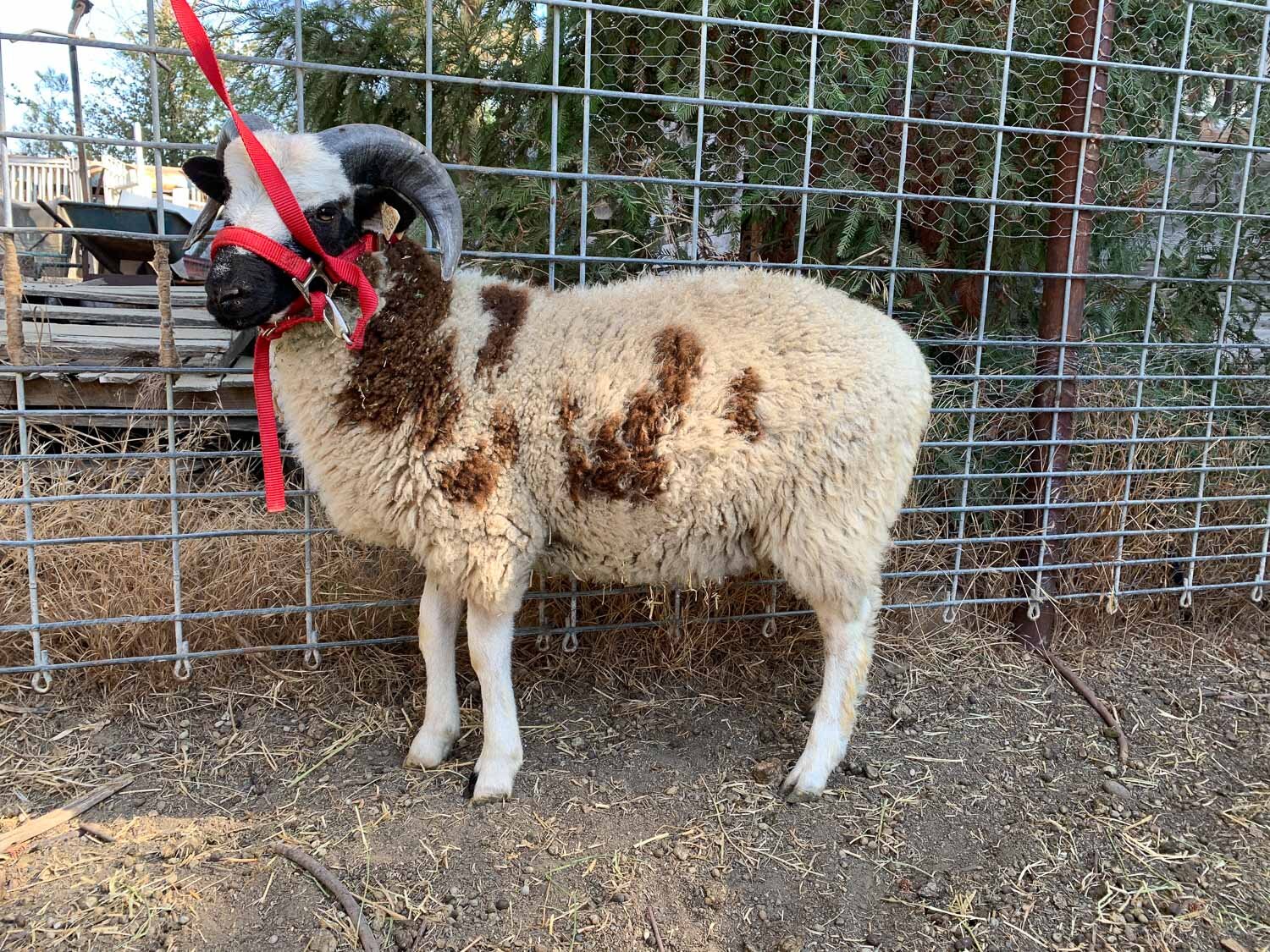
Hillside Barrett came from Michigan last month along with the ewes in yesterday’s post. He is about a month younger than the other ram lambs, but hopefully he’ll be able to handle a few ewes in October.
I just spent the last few hours submitting registration applications for this year’s lambs. So I have current photos and thought I’d make introductions of these and new sheep that I got last month.

Meridian Betsy (Ruby Peak Tamarisk x Meridian Betty) is a ewe lamb that is still on the sale page. I wouldn’t mind keeping her but I probably have too many sheep and I’ll have more next spring.

Meridian Columbine is a ewe lamb out of Cashew, who lambed this spring as a lamb herself.

Meridian Juniper is one of the few lambs sired by the the ram lamb (now yearling), Rambler. Her dam is Jasmine.

Meridian Lupine (Meridian Axle x Meridian Vixen) is the only lilac ewe lamb I kept. She also has almost the most color of all the lambs staying. It seems I ended up with a lot of light lambs.

Meridian Quinci (Ruby Peak Tamarisk x Meridian Quartz) is on the sale page and may be spoken for but if she doesn’t sell I’ll be happy to keep her.

Her sister, Quail, is one that I had my eye on not long after they were born. I thought she looked very flashy. Now that they have grown up I like Quinci’s horns much better than her sister’s. This photo was taken several months ago. I need to get a current photo.

This is another photo from a few months ago. This is Beauty (Meridian Jasper x Meridian Belle), owned and named by my granddaughter.

Isn’t this a cute lamb? She is Patchwork Amara, a lilac lamb from Georgia and is a real sweetheart. I have a t-shirt that reads “You can’t buy happiness, but you can buy a sheep and that’s almost the same thing”. I am very happy because I bought six new sheep that arrived last month. A friend made all the convoluted transportation arrangements and she and I both got sheep from three breeders in Georgia and Michigan.

This is Amara’s BFF, Patchwork BettyLou. They are both very sweet lambs who come up to the fence for treats if the big scary ewes aren’t in the way.

They are now friends with Hillside Grace, a pretty lamb from Michigan.
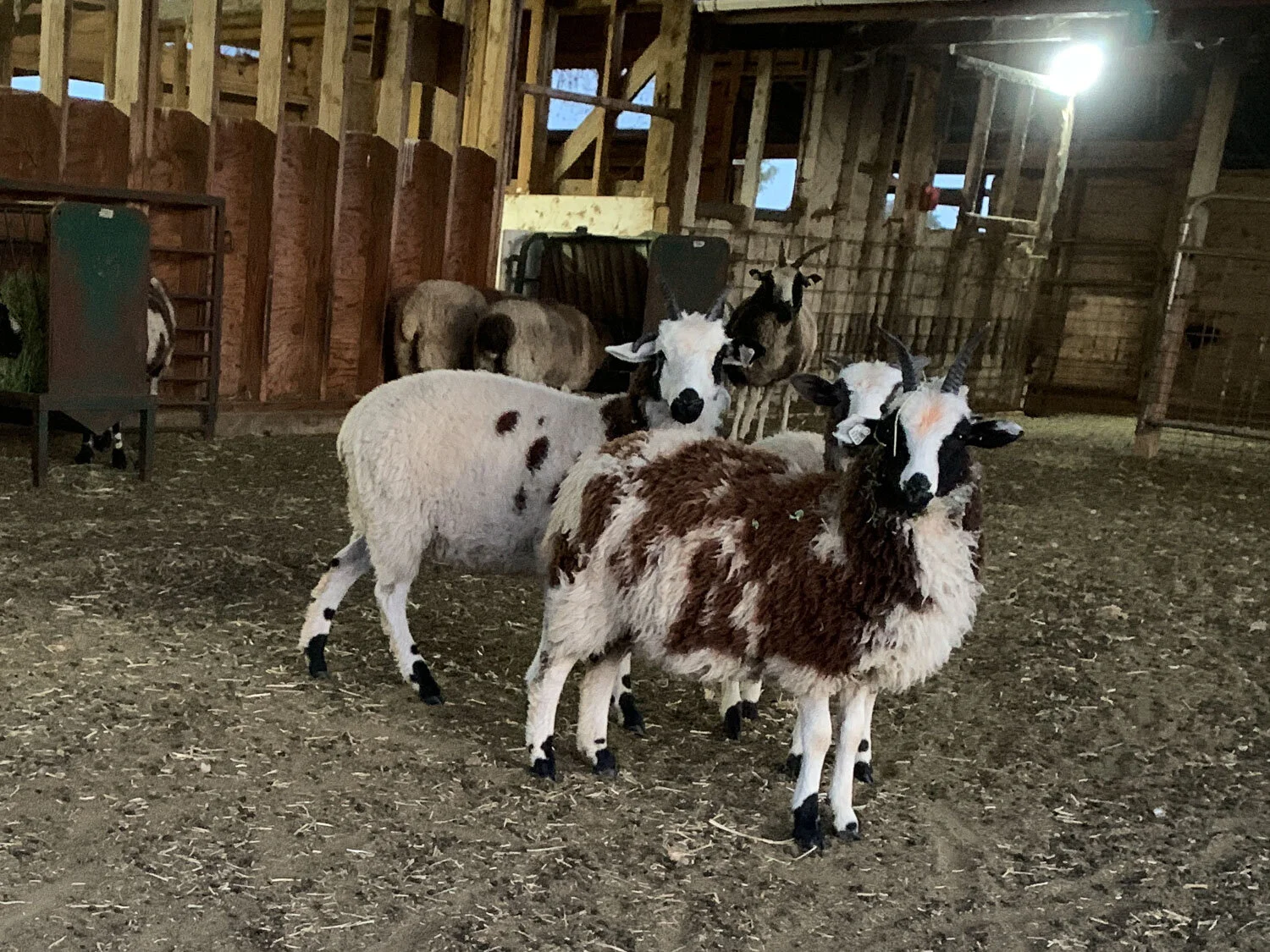
These three all hang out together, often away from the other sheep.

BettyLou and Amara have no qualms about approaching for treats. Grace is much more hesitant but if I’m very still and her friends are right there, she’ll risk it.

Sweetgrass Tranquility and Eilwen are two-year-old ewes who came on the same trip with the lambs. I sure look forward to seeing what their lambs will look like next year.

At first the five new ewes didn’t mingle with the rest of the flock. The two older ewes and the three lambs still associate mostly with each other. I also got a new ram lamb, but I’ll do another post to introduce all the rams.
At Meridian Jacobs farm we raise Jacob sheep and sell locally grown wool fiber, yarn, and handwoven goods. We teach fiber classes and sell Ashford, Clemes & Clemes, and Schacht spinning and weaving equipment. We encourage farm visits with field trips and our unique Farm Club.
Search blog posts since 2019. If the search says it can’t find a post try putting in your search word a second time. I don’t know why but the second time it seems to work.
Search the entire website, including older blog posts.